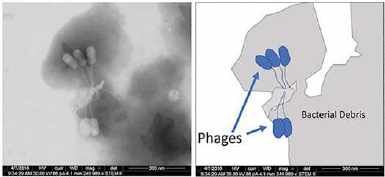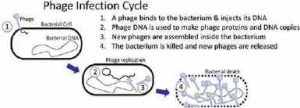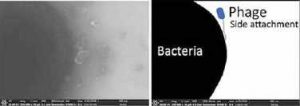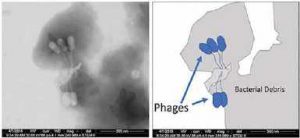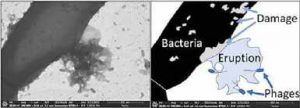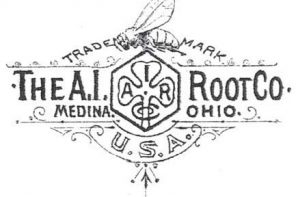By : Gerry Hayes
Phages are a virus that eat bacteria
At the 2019 American Honey Producer Association (AHPA) held in Phoenix, AZ I was rewarded as usual by being able to renew old friendships and begin new ones, all the while learning more about honey bees. You all have heard me say this before but anyone who says that they know everything about honey bees is a liar. So, I am glad to learn more always and the AHPA Conv. is a wonderful place to do that.
American Foulbrood disease (AFB) is probably the most significant bacterial disease that infects Honey Bees. It can kill colonies. It is difficult to ID in its early stages from European Foulbrood (EFB) and Parasitic Mite Syndrome (PMS). Antibiotics can control the actively infective growing ‘vegetative’ stage of AFB. But, the AFB organism, Paenibacillus larvae, is a skilled survivor and when the infection reaches a certain stage it forms a protective ‘spore’ which is a kind of hard-shelled seed that is impervious to antibiotics, changes in heat and humidity, time, and even radiation. This spore can stay alive for decades waiting for the right place and conditions close to honey bee larvae to germinate and infect as an efficient opportunist. It is super tough. Antibiotic control methods we have used for decades were OK but imperfect.
Back in 2017 in the Journal of Invertebrate Pathology, there was a paper titled, “Bacteriophages as an alternative to conventional antibiotic use for the prevention or treatment of Paenibacillus larvae in honey bee hives” (https://www.sciencedirect.com/science/ article/pii/S0022201117302872) by Dr. Sandra Hope, Dept of Microbiology and Molecular Biology, Brigham Young University, (BYU).
I love serendipity. At the AHPA Convention, a person had set up a vendor table right next to where my table was set up. My shy gene is less functional the older I get so it was easy to introduce myself and ask who she was and why she was there. Let’s start there;
Q) Now that I know who was there . . . nice to meet you, Dr. Hope. Let’s start out and get some background (CV kind of) info to set the stage for the Great work you have done. Who are you?
Q) Ultimately BYU has not been known as a hotbed of honey bee research in the past. How come you decided to be a honey bee health researcher? And will you always be one?
A) This is a good point! In fact, I don’t believe any honey bee research was done at BYU before I started my project. As I described above, my profession has always focused on viruses and the immune system. In 2009, I worked with another BYU professor to get a grant from Howard Hughes Medical Institute (HHMI) and begin a research program at BYU to study a new way to combat bacterial infections. HHMI’s focus was on a bacteria related to Tuberculosis, and the HHMI grants expanded to over 100 universities in the U.S., which meant pretty tough scientific competition since we were all focused on the same bacteria.
As our grant was coming to an end, I sat down with my colleagues and I proposed we pick a new bacterial target. That’s when I got a brilliant and exciting thought in my head – I could combine my own love of honey bees with my love to do research! At the time, my colleagues didn’t know that I secretly was a backyard beekeeper at home. I love bees! I love learning about and caring for them. When I told my colleagues that I wanted to do research in Paenibacillus larvae, they both looked at me and asked, “What disease does THAT cause?” In the end, the other two professors picked their own bacterial targets and I was excited to get to work on American Foulbrood.
Q)Explain to us what the title of your paper actually tells us. What is a bacteriophage? And why should we care?
A) The title of the paper is “Bacteriophages as an alternative to conventional antibiotic use for the prevention or treatment of Paenibacillus larvae in honey bee hives.” The word ‘bacteriophage’ derives from the Greek word ‘phage’ which means ‘to eat’, so the name ‘bacteriophage’ literally means ‘to eat bacteria’. Phages, as we like to call them, are a specific category of viruses that can only infect bacteria. Phages are completely inactive towards plants, animals, insects, and anything really, except for bacteria, and are very, very specific for the bacteria that they can kill. Because phages can infect and kill bacteria, they are being studied in greater depth as a new treatment approach to infections rather than using antibiotics to kill bacteria.
One of the most exciting parts about phage research is that the phages are so specific to the bacteria that they kill, so that phages attack a dangerous bacterium and completely ignore any other bacteria – this means that healthy bacteria are not affected. This specificity of phages is different than antibiotics because an antibiotic typically kills bacteria in a broad sense, which means an antibiotic can kill the dangerous bacteria as well as the healthy bacteria.
The other exciting part about phage research applied to a bee disease is the very nature of phage inactivity against everything else. A phage against Paenibacillus larvae is not only organic, but is recognized by researchers as well as the FDA as completely safe for human (and bee) consumption. Phages can be given to bees anytime during the year, no veterinary regulations will be needed, and they are safe regardless of whether it is for spring feeding, during a honey flow, or at Fall feeding to prepare for Utah Winter!
Q)If what I read and understood in your paper is correct you have identified a group of these bacteriophages that can prevent or control AFB without antibiotics. is that right?
Yes. This paper nicely lays out the safety and efficacy of the phages in beehives, but I have to admit that there’s a lot of research that lead up to this particular paper. For instance, just the capture and identification of the phages specific to Paenibacillus larvae has been an amazing scientific journey for me. To capture phages for the project, it took hundreds and hundreds of samples of dead bees (from healthy and infected hives) donated by beekeepers across the country, and from survey samples and from state apiarist samples – these samples were essential for my students to do the work in the lab to try to find and then identify naturally occurring phages that were going to be useful for a treatment. After all of the sample processing, phage identification, and lots of DNA sequencing and testing in bacterial samples in the lab, my students and I were able to pick out the most potent natural killers against AFB and then plan to test those phages for the study that is presented in this research paper. This particular research paper was so exciting for me because it provides the first scientific evidence of using phages to effectively treat American Foulbrood in beehives, and the efficacy even amazed me! Prior to this paper, we had captured and tested other phages, through some amazing work of a former graduate student, Bryan Merrill. Our results of the first types of phages were moderate and more similar to using antibiotics. But after making broad changes to our approach and starting again with hundreds of bee samples to find different phages, we obtained the phages used for the new study presented in this paper, and these phages were a like a laser beam of destruction to AFB! We were able to show that the phages could reverse the damage of infection within three days and completely clear up the infection within 10 days, and recurrence was not detected at any point during the 10-month study.
In this paper, we also showed that the phages given to healthy hives that were at-risk of infection during an outbreak were able to completely prevent the spread of AFB where the transmission rate was otherwise very high. All of these results were done without using antibiotics and the results were far superior to any antibiotic treatment. In the phage treatment reported in this paper, AFB had occurred in a mid-summer outbreak so phages were given during honey flow. After phage treatment, the apiary experienced no more AFB that year, all hives produced honey, and the honey was safe to be harvested and consumed. The hives were strong in Fall and overwintered without issue and without AFB recurrence when observed the next Spring.
Q)Please take as much space and explain to us how these bacteriophages can control AFB. (Photos, diagrams whatever you have to sequentially and visually show how these work would be great)
A) As I mentioned before, phages are a type of virus, which is why my particular scholarly training has prepared me well for research in this area. Phages look different than any other virus – I’ve included an electron micrograph of some phages for you to share with the readers. The phages have an oblong head that contains DNA information, and a long, thin tail with small fibers at the end of the tail that can specifically stick to the bacterial target. In this picture, there are five phages each grabbing onto a fragment of bacterial wall (from a bacteria they had just killed). If you want to compare sizes, phages are much smaller than bacteria.
Phages kill bacteria much the same way that a cold virus kills cells inside your nose. The phage will first stick to the outside wall of the bacteria. Sometimes it will stick on the bacteria sideways until it gets a good grip, and then it stands up and injects its DNA into the inside of the bacteria. The phage DNA will take advantage of the
equipment inside the bacteria to generate new phage proteins and begin assembling many, many copies of the phage. After a while, the inside of the bacteria will become quite full with newly-formed phages. The production of the phages is very energy-consuming to the bacteria and it will begin to feel pretty starved! After all, the phages are eating the insides out of the bacteria. Ultimately, the phages release proteins that destroy the wall of the bacteria so that all of the newly formed phages explode out of the dead bacteria and are now able to stick to any nearby bacteria to start the process again.
This process is obviously extremely destructive, so I know it may sound shocking that phages can be as safe to use as they are. There are several features that contribute to phage safety. First, phage DNA can only be read by the machinery inside a bacteria. This means that other types of species, such as people or plants or animals or insects, do not even have equipment that could read or use the phage DNA. If we eat a phage, it just gets digested. If a piece of phage DNA gets into one of our cells, it can’t be used, so it is destroyed by the regular cellular digestive process for recycling as if it were something like cow DNA or chicken DNA (here you see that I like to use examples of foods I enjoy eating).
The next safety feature is that the tail of the phage and the fibers at the end of the tail are very bacteria-specific. The fibers cannot stick very well to unrelated bacteria, and if the fibers don’t stick
exactly right to make the phage stand up, then the phage can never inject its DNA into a bacteria. This means that the phages cannot infect unrelated bacteria such as lactobacillus or other beneficial bacteria. The fibers that bind and inject DNA, as well as the DNA sequence itself, is so customized that some phages cannot even infect and kill all the different strains of the bacteria that they target! For example, in the research lab, my students have found many phages that act like wimps. They can infect one or two versions of Paenibacillus larvae, but are completely useless when tested on other versions of the bacteria. Quite a bit of our research has been to test every phage we capture with as many strains of Paenibacillus larvae as possible. It was quite a task to find just the exact phages that could, in combination, kill every possible strain we challenged them against. Then if these phages are put with any other bacteria, they can’t infect, they can’t reproduce, and there is absolutely no bacteria-eating at all! I love that this specificity makes phages as safe as they are for our use, while being a silver bullet to AFB.
Q)You were at the AHPA Convention representing a company named Boodsafe. Is that your company? Do they make the bacteriophages?
Q) So there is an actual product that people can buy? How is it used?
Q) How good is it at controlling AFB. Is it a standalone and we don’t need antibiotics anymore?
A) According to my experimental data, the phages are superior to antibiotics at controlling and preventing AFB. However, the Esplin company is specifically not advertising or selling the phages as a treatment, but only as a feed additive. This technicality in distribution and instructions for BroodSafe is due to the fact that the FDA already approves phages to be sold as a feed additive due to their safety as an additive. To sell the phages with labelling as a treatment or preventative for AFB, there is a lot more paperwork needed for the FDA’s stamp, which will likely take years to complete. In light of the current need for managing AFB and the recent restrictions on antibiotics for a feed additive, the Esplin company did not want to delay any longer at getting phages into the hands of beekeepers. Therefore, the company decided to minimize the labelling claims to that of simply a feed additive rather than as a treatment or preventative so they could sell phages now, even though the research data supports what these phages can do.
As an approved feed additive, the beekeeper can decide when to use phages in their supplemental feed. The company (and I) highly recommend that the phages be included in the supplemental feeding in the same place where antibiotics used to be used – for northern states, this is usually a Spring and Fall feeding, and for southern states or migratory bees, it would be prudent to include phages anytime that supplemental feeding is offered. When phages are included in the feed, the phages can be detected in the hive at a high concentration for the first day after feeding. The amount of phages gradually reduce daily until the number of phages returns to the low level that is naturally found in hives. A phage feed additive for AFB management will need to be repeated in the event of new exposure and also in the event of left-over AFB spores that are very hearty.
Because of AFB spores, it is highly unlikely that AFB will be eradicated, but the use of phages for management is far safer and less irritating to bee health than the use of antibiotics for management. Phages obviously add a level of safety to the bees, honey, and other bee-related products compared to the use of antibiotics where any bee products must be discarded if produced during an antibiotic feeding. It would be wonderful if phages could replace the use of antibiotics so that there was no need to destroy such precious products of the hive.
As for whether antibiotics are needed anymore . . . just remember, these phages are specific only to the bacteria that causes AFB. These phages cannot touch other bacteria, so they absolutely cannot help with European Foulbrood. Another aspect of phages is that bacteria do have a slow mutation rate and it is possible that over time (say 10 years), the bacteria could evolve to survive the current phages.
Q)Can it be improved?
Q)This is pretty cool. What’s next?




